News and Site Updates Archive 2009/12/31
I propose getting rid of conventional armaments and replacing them with reasonably-priced hydrogen bombs that would be distributed equally throughout the world.
- Idi Amin
31 Dec '09 - Please note that this site first went live on 28 December
1999, meaning that it is now more than a decade old. I hope I'll find the next 10 years to be as informative.
|
 |
A sinkhole, also known as a sink, shake hole, swallow hole, swallet, doline or cenote, is a natural depression or hole in the
surface topography caused by the removal of soil, bedrock, or both, by water. Sinkholes may vary in size from less than a metre to several hundred metres in diameter and depth, and vary in
form from soil-lined bowls to bedrock-edged chasms. They may be formed gradually or suddenly and are found worldwide. Terms are often used interchangeably though many will distinguish
between those features into which a surface stream flows and those which have no such input (only the former would be described as sinks, swallow holes or swallets). This site has lots of good information on sinkholes and many interesting photos - however it's a blog with months of postings all on a single
huge page, which makes it difficult to find what you seek. Try Google Maps to view the sinkholes in Avon Park, Florida (+27° 35' 52.48", -81° 29' 48.78"). |
 |
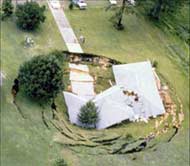 |
From that same site: Can "x-ray vision" (Advanced Visual Inspection Methodology) indicate imminent sinkhole
collapse? Apparently so - visual clues Indicate the risk of sinkholes in Florida, Texas, Pennsylvania and other susceptible areas. In some parts of Florida, it is risky to have your
house over your well - pump out enough water and you could find yourself trading your residence in on your own personal sinkhole. Sinkhole information site if you want more. |
 |
 |
I'm attracted by photos showing huge crowds, so I liked this image as soon as I saw it, though I knew nothing about it. I've subsequently learned the photographer was Arthur Fellig (1899 - 1968), known professionally as Weegee (nicknamed after a Ouija board due to an uncanny ability
to show up at crime/accident scenes mere moments after their occurrence). He captured tenement infernos, car crashes, gangland executions, washed-up lounge singers and teenage murder suspects
in paddy wagons at, as he put it, their most human. He photographed Coney Island couples kissing on beach blankets and late-night voyeurs on lifeguard stands watching. Everywhere, he
snatched images of people sleeping: drunks on park benches, whole families on Lower East Side fire escapes, men and women snoring in movie theatres. He was Supreme Chronicler of the city at
night, one of the most prolific and famous news photographers of the century. His first book, Naked City, (written
in 1945 and still in print) inspired the movie genre film noir, which explores the dark side of human nature. Visually, the genre took cues from his overexposed faces, figures emerging from
shadows, and grotesque circumstances. Weegee developed his film in his car trunk, then typed his article - ready to sell to any reporter coming late. (His special secret was a police
radio in his car.) In 1930, flashlight powder explosions were a newspaper cameraman's chief
hazard. Flashlight guns heated up after a shot and needed time to cool before another load of powder was poured in - but when things broke fast, there wasn't always time. Cameramen
ran a constant risk of hand or face burns (or even fingers blown off) with the use of flash guns. Flashlight powder itself, composed of magnesium and potash, was more explosive than
dynamite. |
 |
Something about this appeals to me - not entirely sure why. It's an outdoor extension to a private dwelling in
San Francisco. Situated in a tightly packed urban neighbourhood, the limited-space outdoor garden has one large tree. This sole arboreal presence is used to establish a
gravitational pattern of grooves that are focused towards it. It was designed with 3D software then custom-milled using marine-grade plywood. Though the surface appears to bend and dip
toward the maple tree, it is actually a flat horizontal plane made up of individual plywood tiles. |
 |
The author of A Parent's Guide to Adoption Disruption and
Dissolution writes: "For years, I never mentioned the fact that I had suffered through two disruptions. Emotionally, they felt like miscarriages or even abortions, and no one wants to
hear about loss. But over the years, I've learned that I have every reason to feel pride about my personal stats. I've attempted to adopt 11 times, all high risk children with special
needs, most of them older children who had spent a lot of time in the system. Some of these were highly questionable matches that the adoption agency should have steered me away from, in
favour of a child whose needs I could better meet. But I trusted the agency too much, expecting it to be infallible. From what I've learned about disruption risk and large family
dynamics, it's almost miraculous that 9 of these adoptions have been successful and only 2 disrupted. Adoptive parents who try everything before giving up and who only give up when safety
concerns force them to, should have no regrets. They should hold their heads up high. Supermom, after all, is a mythical being." The personal stories in the comments section are
sad. And real. |
 |
Who is this well-known mystery man? (Click
here once for a quick answer, otherwise, see the last photo on the page after the jump.) |
|
 |
When did William the Conqueror invade England? Ten Sixty-Six. When did Christopher Columbus cross the Atlantic? Fourteen Ninety-Two. When was the Declaration of Independence
signed? Seventeen Seventy-Six. And that Tchaikovsky piece? The Eighteen Twelve Overture. Pearl Harbor? Nineteen Forty-One. How did Prince want us to
party? Like it's Nineteen Ninety-Nine. In those good old days literally no one had to spell it out. If you saw the year 1950, you knew to say "Nineteen Fifty," not One Thousand, Nine
Hundred, Fifty. No questions asked. Then came the new millennium — the stentorian Year Two Thousand. The Year Two Thousand led to Two Thousand One, Two Thousand Two and so on, as if
we were counting pennies in a jar. Perhaps it was habit. Perhaps Two Thousand One landed on the ear better than Twenty-Oh-One, but with the turn of a new decade, it's time to go back to the ways of saying the year that served us so well for centuries:
Twenty-Ten sounds perfectly natural - clocking in at 3 syllables, it's more economical than the ponderous mouthful that is Two Thousand And Ten. |
 |
Slight good news that may accompany global warming:
Extreme cold is the deadliest form of extreme weather
(almost twice as bad as extreme heat). |
 |
 |
Back in 1999, San Francisco voters were pitched a $299 million bond to "save" Laguna Honda Hospital as a 1,200-bed facility for the city's frail, elderly population. Who
doesn't want to help the frail and elderly? A decade later, the Department of Public Works project is still incomplete, its price tag has swelled by nearly $200 million, and the hospital is
slated to hold only 780 beds — so the city is going massively over budget to construct a hospital only 65% as large as promised, which is 4 years behind schedule. Amazingly, this gets
worse. After securing the bond funding to save Laguna Honda as a hospital for the elderly, the Department of Public Health began transferring younger, often dangerous and mentally ill patients
there and mixing them among the old people. This went about as well as you'd think. To address this problem, staff erected signs reading "No Hitting." (That worked about as well as
you'd think, too.)
San Francisco may be the worse-run big city in the US... |
 |
Logistically, an all-encompassing security system is probably impossible. A new safety protocol that adds 30 seconds to the check-in time of every passenger would add more than 3 hours to the
preparation time for a 747 (assuming no additional checkpoints). Reforms that further encumber the country's already overstressed air-traffic system are hardly reforms; they are self-inflicted
wounds. Airport-security measures have simply chased out the amateurs and left the clever and audacious. Improvements in airport security have historically not worked - yet in response to
a failed terrorism attempt, a struggling industry in a struggling economy (and the poor saps stuck as customers) will have to deal with more restrictions imposed not because there's any
empirical support for their effectiveness, but so the TSA can appear to be Vigilant and Responsive. If some terrorist organisation wants to change its stated goals to killing the US airline industry, they can
probably declare victory relatively soon. (To be fair, a recent online poll of Kiwis shows the majority - by almost 2-to-1 - feel that airport security should be strengthened.) |
 |
This was a bungled attempt at using a chemical which already failed on another flubbed bombing. The government claimed it was made by Al Qaida’s best bomb maker. So? Then why fear
them? Could this be an attempt to focus attention away from something either by Al Qaida or by our government? Did he make this chemical compound himself and just say Al Qaida gave it to
him because he wanted notoriety? Is this attempt a rogue CIA operation to justify more war or weaker civil rights? Or an exercise to justify invasion of Yemen? The military started a
covert war in Yemen about a year ago and this sounds something like what happened with Afghanistan. How many countries are we going to invade? PETN or pentaerythritol
( C(CH2OH)4 + 4HNO3 → C(CH2ONO2)4 + 4H2O ) is sensitive to shock or heat and is usually used as core detonation device for different types of explosives; it's rarely used on its own. PETN
preparation involves the nitration of pentaerythritol using concentrated nitric and sulfuric acid - but sulfuric acid can make PETN unstable. Did he mix acids or use a single one? Since the
goal was to blow up the plane while coming into Detroit, maybe he used the more stable form. Experts say the amount he had should've blown a significant hole in the wall of the plane. His
father reported he had radical leanings; he was put on a watch list. Janet Napolitano, US homeland security chief, said information has to be specific and credible to put someone on a no-fly
list. The US can put someone on a list to be pulled out of line and searched at airports because of being outspoken about a particular regime. If they can do that to those who are no danger
to others, why can’t they have a database to flag certain people? The DEA is notified if certain people fly (keep that drug war going - we have priorities). Was this incident staged or allowed to happen so the public will stop complaining about Whole Body
Scanning? (For example, Senator Joe Lieberman, chairman of the Senate Homeland Security and
Governmental Affairs Committee, called for more widespread use of the full-body scanners after the aborted attack. "We were very lucky this time but we may not be so lucky next time, which is why
our defences must be strengthened.") |
 |
The Le Cob, made of Corian® and glass, holds significantly less water than a conventional bath and can be used in a similar way
to the traditional Japanese soaker baths (bathe first, relax after). The soothing cascade overflow is naturally therapeutic, reminiscent of a river, as the water falls onto the pebbles
below. This design pays homage to Le Corbusier’s Chaise lounge. (So why isn't it called Le Corb, then?) |
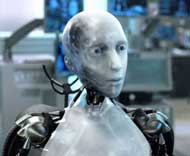 |
A singularity is a point at which an otherwise continuous mathematical progression becomes infinite, implying that
all continuous extrapolation breaks down beyond that point. Technological singularity refers to the idea that technological progress would reach such an infinite or extremely high value at a
point in the near future. This idea is inspired by the observation of accelerating change in the development of wealth, technology, and human capability for information
processing. Extrapolating these capabilities to the future leads a number of thinkers to envisage the near-term emergence of a self-improving artificial intelligence or super-intelligence that is
so much beyond humans' present capabilities that it becomes impossible to understand it. A rough cyberpunk definition of singularity would be a smarter-than-human creation that accelerates technological advancement
beyond human ability or control (or even understand). That idea is often employed in science fiction as an artificial intelligence or brain-computer interface, but could also include biological
augmentation or genetic re-engineering of the brain or else emulating the brain based on high-resolution scans - or even nanotechnology. As you can imagine, this will have a major impact on
humanity’s place in the universe. The singularity may try to help humans and elevate them to singularity status or may see them as beyond hope and do nothing, concluding that attempts to change
them would be a waste of time and energy. Worse yet, the singularity may see itself as a god among inferior meatbots and use its power to wipe human flesh out of existence (think
what humans have done to whales). |
 |
By 2020, memory devices will be integrated into our clothing and the very idea of a "smart phone" will begin to change. Rather than looking at a tiny screen, our glasses will beam
images directly to our retinas, creating a high resolution virtual display that hovers in air. That virtual display will be able to take over our entire visual field of view, putting us in a
3-dimensional full-immersion virtual reality environment. We won’t just be able to lengthen our lives; we’ll be able to improve our lifestyles. By 2020, we'll be testing drugs that will
turn off the fat insulin receptor gene that tells our fat cells to hold on to every calorie. (Holding on to every calorie was a good idea thousands of years ago when our genes evolved in the
first place but today it underlies an epidemic of obesity.) By 2030, we'll have made major strides in our ability to remain alive and healthy – and young – for very long periods of time. At
that time, we’ll be adding more than a year every year to our remaining life expectancy, so the sands of time will start running in instead of
running out. |
 |
A common theme in futurist predictions is that revolutionary technology of one sort or another is just around the corner, and that this technology will allow people to live forever. This can mean
physical immortality or some more abstracted technique like downloading one's personality into a computer. The "singularity", which Ray Kurzweil says will arrive "by 2045 or thereabouts", is a
prime example. And thus we come to the Maes-Garreau law, which states that any such prediction about a favourable future technology will fall just within the expected lifespan of the person
making it. Pattie Maes, a researcher at the Massachusetts Institute of Technology, observed in the late 1980s that many of her male colleagues were interested in these ideas, and tabulated when
they expected the miracle technology to arrive. Sure enough, she found that the
dates they predict for the singularity are always on or around their 70th birthdays. |
|
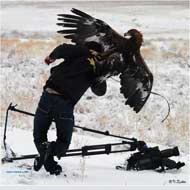 |
 |
 |
 |
|
A hunting golden eagle attacks a
cameraman during an annual hunting competition in Chengelsy Gorge, some 150 km (93 miles) east of Almaty on 5 December 2009. When it snows on the steppes of eastern Kazakhstan,
hunters saddle up and gallop off with eagles on their arms in search of prey. Many see eagle hunting as a symbol of their nation's nomadic past and a throwback to an oft-romanticised era
before these steppes became a geopolitical battleground between competing regional powers Russia and China. |
Taken in Tenerife February 2009. Stooping eagles can fall like
meteors. |
Golden eagles are capable of taking very large
prey. This is a 1-year-old female with a 5-foot wingspan (white on the underside of the wings distinguishes a juvenile from an adult), probably hatched in Quebec or Labrador and
trapped in Pennsylvania. She weighed 8.4 pounds and was radio-tagged and released. She seems to have remained in the Pennsylvania area thereafter. |
Lakelse River, Terrace, British Columbia, Canada: The adult trumpeter swan was flying over a river when the bald eagle swooped out of nowhere
baring its talons. The eagle - massive 2-metre-wide wings outstretched - landed on the swan. Remarkably, after a 5-second stuggle, the swan escaped the eagle's clutches and
managed to fly down to the water. Smarting from defeat, the eagle headed for nearby trees. |
|
 |
People make optimistic predictions about themselves. They expect relationships to last longer, tasks
to take less time and things to turn out generally better than they will. And when they ask for a waffle-maker for Christmas, they think, "I'll use this all the time!" But sometimes the
reality of owning an object doesn't quite measure up to expectation. The cappuccino machine is a hassle to clean, the fancy navigation system is not necessary for most driving, and no one has
time to play the new piano. Consumers might want to think about this before making another addition to their already crowded drawers and countertops. Overspending and clutter are a
predictable result of acquiring something with the mistaken belief you will use the item more often than you actually will. Via the New Shelton wet/dry. |
 |
The Salem hypothesis, first proposed by Bruce Salem, claims that "an education in the engineering disciplines forms a predisposition to [creationist] viewpoints." This was rephrased somewhat by
P Z Myers as "creationists with advanced degrees are often engineers." Is there any evidence to back this up, or is it just a
gratuitous slander against engineers? A 1982 article in the Proceedings of the Iowa Academy of Science suggested that many leading creationists trained as engineers. But the article
did not present any figures. More recently, Diego Gambetta and Steffen Hertog have noted a preponderance of engineers among Islamic extremist groups. They suggested that engineers may be at
greater risk of being recruited by such groups than other graduates. Obviously creationism is not the same thing as violent activism, but Gambetta and Hertog's analysis may be useful nevertheless because they discuss the engineering mindset in some
detail. They show, for instance, that engineers are more likely to be religious
than other graduates. |
 |
Most of us seem to be far better at remembering who's told us what compared with to
whom we've told what. Psychologists characterise this as a distinction between "source memory" and "destination memory". We're poor at remembering to whom we said what because of the
self-focus associated with disclosing information, rather than receiving it. This self-focus disrupts the memory processes that would otherwise associate what was said with to whom it was
said. The good news is that there may be a remedy: try focusing less on yourself and more on your listener. Sixty undergrads looked at pictures of faces - half received a single fact from
each face in written form; the other half told a fact to each face. Afterward students were tested on memory for which facts were associated with which faces. Those who'd received
facts performed significantly better than those who'd told facts. Memory for the facts themselves was no different between the two groups. Destination memory was improved when students said
each person's name before disclosing a fact to them. (Perhaps this is why successful pressure salesmen say your name in the conversation so much?) |
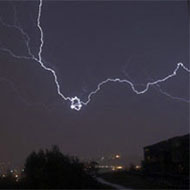 |
This image is the final picture in a series of 18. It was the only one I truly found
impressive. I could find no explanation offered anywhere for what might have caused this circular knot of lightning. If anyone reading this has information,
please let me know. The photo was taken in 2006. |
|
 |
This dog (at left) is supposed to be wearing a Sarah Palin costume - but it isn't a pit bull and I see no lipstick. Perhaps
Marley (at right) is a cuter example of how the right wig can transform your dog? I mean, few things are more important in the long run than making sure your dog is cute enough to attract
favourable attention - right? |
 |
|
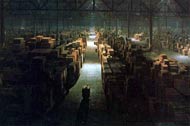 |
Some ridiculous ceremonial gifts George W Bush received as president: a riding coat, a samovar, Moser crystal champagne flutes, a silver sword "with elaborate detailing and carnelian stones." Why
the taxpayers of Australia had to pay for an $852 fishing rod given to a man who’s already quite rich is not clear — especially since other nations should know that US law forbids the president and
cabinet officials from keeping state gifts worth more than a token amount. At White House gift-giving ceremonies, there is always an official present who catalogues the gifts and confiscates
them once the foreign dignitary departs. The ceremony at which Italian diplomats presented Bush with 18 Marinella and Ferragamo silk ties, paid for with money forcibly extracted from the pockets
of Italian taxpayers, must have been a hoot. Former Secretary of State Condoleezza Rice received a $230,000 diamond-and-sapphire necklace from King Abdullah of Saudi Arabia. Is the Saudi
embassy in Washington so dim it doesn’t know US law prevented Rice from keeping the jewellery? Plus that $230,000 didn’t come out of the king’s pocket - it was presumably stolen from the Saudi
people. There is now a huge swag pile accumulated during Bush’s terms and the stuff will go to - a government archive. That is, it will be put away in an enormous storage room like the one
at the end of Raiders of the Lost Ark, never to be seen again. Why aren’t gifts
auctioned off to reduce the federal debt? Or perhaps the "tradition" could be scrapped as archaic? |
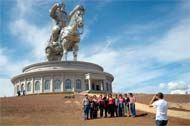 |
According to legend, when Genghis Khan died in 1227 in what is now northern China, his lieutenants wanted to keep the death a secret from the Mongols' enemies. So as the party accompanying his
body made its way back to Mongolia, they killed every person they saw on the way - more than 20,000 - so news of the death wouldn't spread. Then, when they buried Genghis, they either redirected
a river to cover the site, or set horses to trample the ground so no trace would be seen, or killed all the people who buried him, and then killed those killers. (Yes, but who, then, killed the
lieutenants?) There is no hard evidence that any of those things happened. It may well be that they are after-the-fact embellishments designed to explain a remarkable circumstance of
history: the location of Genghis' tomb remains a mystery. Shown is a 40-meter-high
statue of Genghis Khan about 50 kilometres from the Mongolian capital Ulaanbaatar. In Mongolia, Genghis is revered to a degree approaching that of a deity. His image appears everywhere,
including on a tapestry in Ulaanbaatar's main monastery and as a statue in front of the parliament building. Ulaanbaatar's airport and popular brands of beer and vodka are named after
him. Via Naacal. |
 |
It has been known for a while that stressful conditions such as famine result in more girls being born than happens in good times. The shift in the sex-ratio is small — around 1% — but in a
large population that is still noticeable. A possible evolutionary explanation is that daughters are likely to mate and produce grandchildren regardless of conditions, whereas weedy sons may fail
in the struggle to have the chance to reproduce at all. In hard times, then, daughters are a safer evolutionary bet. Regardless of why the shift happens, though, it has long been argued
that the moment when it happens is conception — or, more probably, implantation. A womb exposed to stress hormones, runs the hypothesis, is less likely to accommodate a male fœtus. A
recently published study, however, suggests this ain’t necessarily so. Apparently, stress-induced sex selection can take place long after conception and implantation. It seems that stressed mothers may spontaneously abort male fœtuses. |
 |
Telomeres are repetitive structures at the end of mammalian chromosomes and together with associated proteins they cap and protect chromosome ends. In normal cells, a progressive telomere
shortening accompanies each cycle of replication and there is a well-established gradual loss of telomere length with increasing age. Short telomeres are associated with decreased survival,
mostly due to a higher mortality rate from heart and infectious diseases. Increased oxidative stress is a characteristic feature in patients with cardiovascular disease. Oxidized
low-density lipoprotein reduces telomerase activity and accelerates senescence. (Telomerase is an enzyme that is able to lengthen telomeres.) Short telomeres have also been described in
diabetic patients and in individuals with increased pulse pressure, obesity, high fasting glucose levels, and smoking, as well as in response to psychosocial stress. Taken together, these data
strongly indicate that telomere length can serve as a biological marker for age-related and stress-related conditions. In other words, short telomeres significantly correlate with an unhealthy lifestyle. Obesity is associated with systemic chronic
inflammation, which also can affect telomere length by increased proliferation. |
 |
When Americans begin routinely complaining about how they hate their government and don’t trust their leaders, it may be time to look warily at the homicide rate. People’s views about the
legitimacy of government and how much they identify with their fellow citizens play a major role in how often they kill each other. Evidence suggests that the predisposition to murder is rooted
in feelings and beliefs people have toward government and their fellow citizens. Poverty and unemployment don’t lead to higher murder rates and locking up criminals, using the death penalty, and
adding more police don’t hold the murder rate down either. Four factors that relate to the homicide rate in parts of the US and western Europe throughout the past 400 years are: the belief that
one’s government is stable and its justice and legal systems are unbiased and effective; a feeling of trust in government officials and a belief in their legitimacy; a sense of patriotism and
solidarity with fellow citizens; and a belief that one’s position in society is satisfactory and that one can command
respect without resorting to violence. (This may hold relevance for terrorists as well.) |
 |
Does an investor prefer a statement showing only an aggregate loss of $95 – or one showing a loss of $100 and a gain of $5? Communicating "I have some good news and some bad news" is better than
combining messages into a single, bleak result when small gains and large losses occur together. The smaller the positive amount ($5 in the example) and the larger the negative one ($95), the more
people prefer that the information be presented in separate sections rather than summed together. In finance, a mutual fund posting a quarterly loss would be better perceived by investors if the
accompanying information pointed out the portions of the portfolio that posted a gain. In retailing, automobile manufacturers and dealers will be better appreciated by potential customers if they
price a car at $20,000 with a $500 rebate than if they price the same car at $19,500. This is called the
Silver Lining Effect. |
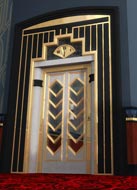 |
The first reference to an elevator is in the works of the Roman architect Vitruvius, who reported that Archimedes built his first
elevator, probably in 236BC. In some literary sources of later historical periods, elevators were mentioned as cabs on a hemp rope powered by hand or by animals. It is supposed that
elevators of this type were installed in the Sinai monastery of Egypt. In the 17th century the prototypes of elevators were located in the palace buildings of England and France. In the
middle 1800's, there were many types of crude elevators that carried freight. Most of them ran hydraulically. The first hydraulic elevators used a plunger below the car to raise or lower
it. A pump applied water pressure to a plunger, or steel column, inside a vertical cylinder. Increasing the pressure allowed the elevator to descend. The elevator also used
a system of counter-balancing so that the plunger did not have to lift the entire weight of the elevator and its load. A plunger, however, was not practical for tall buildings, because it
required a pit as deep below the building as the building was tall. In 1882, when hydraulic power was a well established technology, a company later named the London Hydraulic Power Company was
formed. It constructed a network of high pressure mains on both sides of the Thames which, ultimately, extended to 184 miles and powered some 8,000 machines, predominantly lifts (elevators) and
cranes. The system closed in 1977. The company, as a UK statutory authority, had the legal right to
dig up public highways to install and maintain its pipe network. This made it attractive to Mercury Communications (a subsidiary of Cable & Wireless) who bought the company and used the
pipes as telecommunications ducts. |
 |
Betty Lou Oliver is best known as the 1940s elevator attendant for the Empire State Building who survived two horrific
accidents on the same day. Oliver was working on the 80th story of the building on 28 July 1945. On that day, due to thick fog, William F Smith Jr crashed into the north side of the Empire
State Building in a B-25 Mitchell bomber. The plane struck the 79th floor of the building. The 20-year-old
woman had just opened the door to her elevator on the 75th floor when the B-25 exploded. The blast threw Oliver out of the elevator and across the hall where two women from a nearby office
found her. Oliver was badly burned and the two women gave her first aid before helping her into another elevator to reach medical care. Just as the doors closed, the (damaged) elevator
cables snapped sending Oliver and a second female operator plummeting towards the ground. Coast Guard pharmacist Donald Maloney was waiting for an elevator on the ground floor when he heard the
screams of the two girls as their elevator car hurtled past. Maloney and nearby firemen raced downstairs, fearing the worst. Once the firemen used axes to break through a wall, the
guardsman crawled into the elevator car and discovered both women battered but still alive. Emergency hydraulics applied brakes to the plunging car, and severed cables hanging beneath the
elevator piled up and acted like a coiled spring that slowed the elevator as it fell. Air trapped within the confined space was also compressed by the falling car, building up pressure that
slowed the elevator's descent. Oliver was treated at the hospital for serious injuries. Her descent still stands as the Guinness World Record for the longest survived elevator fall ever
recorded. |
| |
|
  
I believe more people would be alive today if there were a death penalty.
- Nancy Reagan

For other updates click "Home" (for the latest) or "Next" (for older) below
|
 Animals
Animals Animation
Animation Art of Playing Cards
Art of Playing Cards Drugs
Drugs Education
Education Environment
Environment Flying
Flying History
History Humour
Humour Immigration
Immigration Info/Tech
Info/Tech Intellectual/Entertaining
Intellectual/Entertaining Lifestyles
Lifestyles Men
Men Money/Politics/Law
Money/Politics/Law New Jersey
New Jersey Odds and Oddities
Odds and Oddities Older & Under
Older & Under Photography
Photography Prisons
Prisons Relationships
Relationships Science
Science Social/Cultural
Social/Cultural Terrorism
Terrorism Wellington
Wellington Working
Working Zero Return Investment
Zero Return Investment


































